
views
X
Research source
Being held is not natural for hamsters so you will need to make sure you know how to hold your hamster properly.
Acclimating Your Hamster To You

Do not handle them right away. If you just brought your hamster home, chances are they will need a little time to get used to you before they will enjoy being handled and held. Wait at least 12 to 24 hours before trying to hold them. Crouch near your hamster's cage and speak to them in a soft, friendly voice. You can also get them comfortable with your presence by simply reading a book or watching TV in the same room as them. Make sure your hamster can see you and knows you are a friend, not a predator.
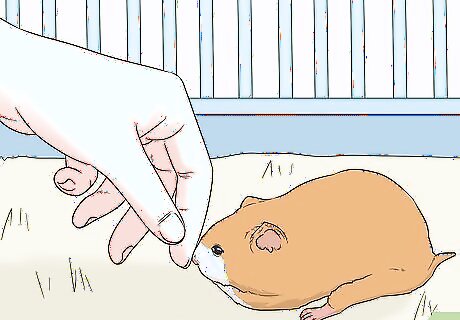
Place your hand in his cage. In the wild, hamsters are grabbed only by a predator, so your hamster will need to learn that you are not acting as a predator when you hold him. Start by placing your hand in their cage and leaving it there for them to investigate. So as not to startle your hamster, hold your hand limply in their cage. It would also be helpful to hold your hand as a clenched fist initially. You can unclench your fist, with your palm facing upward, as he becomes more comfortable with your hand. Hamsters have a tendency to nibble as a way to test their environment. If your hamster starts to nibble at your hand, gently pull your hand away. Jerking your hand away will startle him and may make him more reluctant to approach your hand.

Entice your hamster with treats. Your hamster may be very wary of your hand. If this is the case, try placing treats in your hand to encourage him to approach you. When he is comfortable accepting treats from your hand, he will be more amenable to you picking him up. Ideal treats are those that your hamster would normally eat in the wild. For example, you can treat him with fresh, rinsed vegetables (e.g., broccoli, cauliflower, carrots) and fruits (e.g., bananas, berries). Make sure to chop the treats in small pieces before feeding them to your hamster.
Picking Up Your Hamster
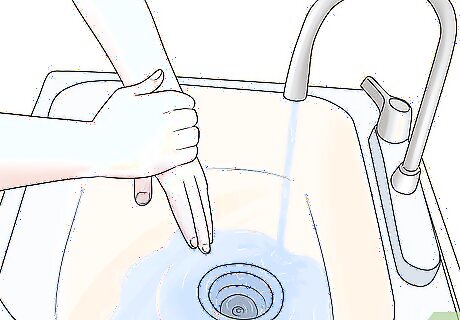
Wash your hands. Hamsters rely on their noses to navigate their environment, and strong smells can cause them distress. Washing your hands before handling your hamster will help him feel more comfortable. Use an unscented soap—a fruit-scented soap may make your hamster see your hand as food. Washing your hands is especially important if you have more than one hamster. The scent of another hamster on your hands could make the hamster you are handling feel like he is being attacked.
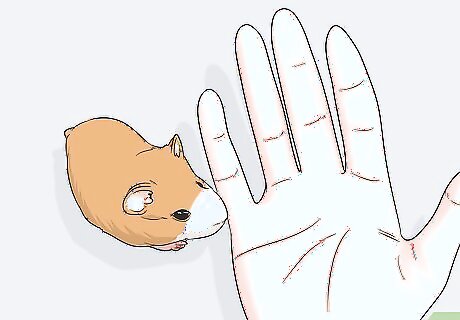
Let your hamster see your hand. In the wild, hamsters have few defenses other than running. Any sudden changes in your hamster's environment can be very alarming to him, so it is very important that he can see your hand approaching him. When you place your hand in your hamster's cage, leave it there for at least a few seconds so that he can acclimate to it.
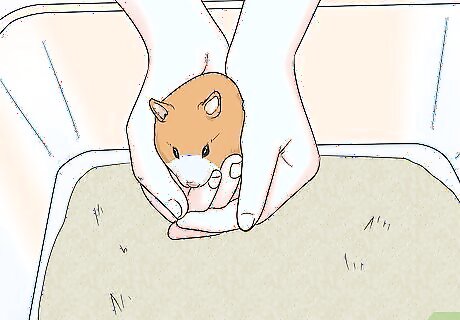
Cup your hamster in the palm of your hands. It is very important for your hamster to feel secure in your hands when you hold him. When he climbs into your hand, cup your hand under him to support him. Cup your other hand so that he can rest comfortably and securely in the palms of both of your hands. If your hamster does not want to climb in your hands, consider using a scoop. Allow him to walk into the scoop before lifting him up. You can them transfer him from the scoop to your hand when you have him out of the cage. You can also use a 1-liter plastic soda bottle, cut in half, like a scoop. Place the bottom half of the bottle in your hand, and let your hamster crawl into it. He will feel the warmth of your hand, but will not be able to bite your hand through the plastic. Make sure the bottle's edges are smooth. With time, your hamster will become more comfortable with being held and you will not need to lift him with a scoop.
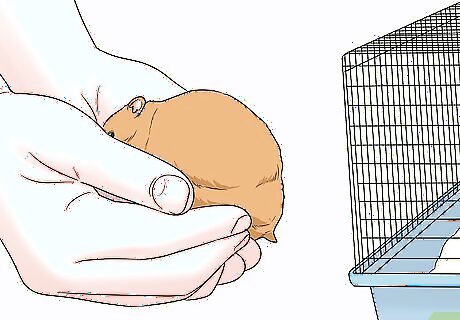
Lift your hamster out of his cage. Being lifted up can be very disorienting and frightening for your hamster. Before lifting him up, face him towards you in your hands. This will give him a frame of reference and will make him less likely to jump, as you lift him up. Lift him up slowly and gently. Be aware that your hamster may start biting your hand as you lift him up. His bites will likely not be enough to break the skin but will serve as more of a warning signal that he is feeling alarmed. If he starts to bite, gently blow a puff of air in his face. The hamster will take a step back and blink, wondering what he just smelled. This gives you time to free your hand from his grip.
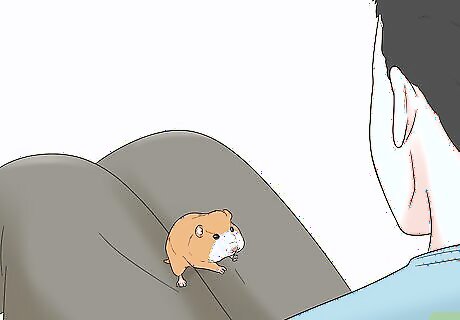
Hold your hamster in your lap or close to your chest. Keeping your hamster close to your body as you hold him will keep him safe. It will also prevent him from trying to run or jump away.
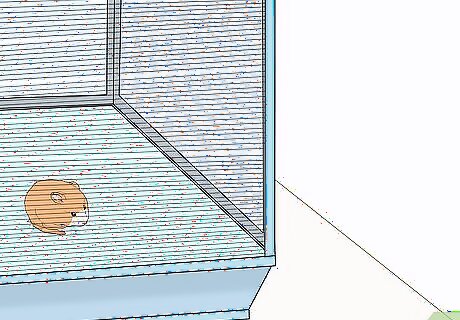
Place your hamster back in his cage. Because your hamster is not used to being held, he will probably not want to be held for long periods of time. If he seems agitated or is trying to bite you, gently lower him back in his cage. Gently lower your hamster back in his cage. Hamsters can easily injure themselves if they fall, so you should lower your hamster until he can easily walk out of your hands and onto the bottom of his cage. You can spread out your palm and allow him to simply step off your hand. Hold him for a short period of time initially (less than a minute), then work your way to longer stretches of time as he becomes more comfortable with being held.
Taking Precautions When Holding Your Hamster
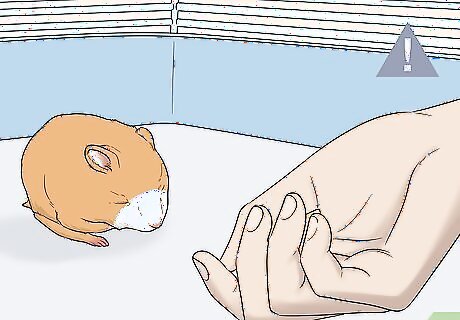
Do not hold your hamster when he is sleeping. Hamsters tend to sleep very deeply. In the wild, they will burrow deep into the ground where they can sleep relatively undisturbed. If you wake him up suddenly to hold him, he will likely interpret this as trouble (e.g., a predator) being nearby. If you would like to wake him up, do so gently. For example, you can speak softly to him. You can also gently ruffle your hand in his bedding.
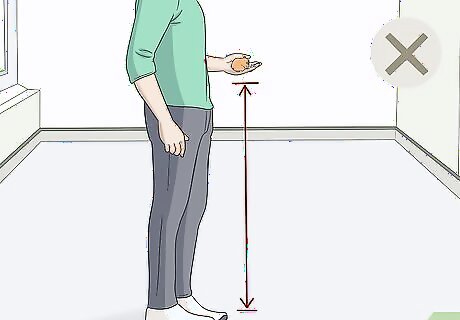
Do not lift him up high up off the floor. Hamsters are very prone to injuries from falling, so you should keep your hamster fairly close to the ground when you are holding him. Do not lift him more than 12 inches (30 centimeters) off the floor. If he tries to make a run for it, keeping him close to the floor lessens the likelihood of injuring himself if he jumps. Consider holding him when you are lying back on the floor, which would keep him even closer to the ground.
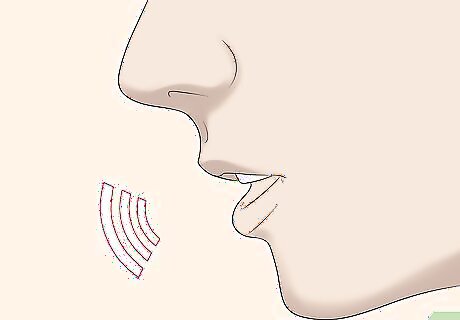
Avoid making kissing noises when you are holding him. Talking to your hamster in a calm and soothing voice will help him feel more comfortable with being held. However, kissing noises can actually be frightening to him.

Do not scruff your hamster or pick him up by an appendage. Scruffing your hamster to pick him up can put immense pressure on his head. This pressure may be enough to cause his eyes to prolapse. You should also never pick up your hamster by one of his appendages. Not only would this likely injure your hamster, but he would also be even more disoriented by being lifted in the air by his legs.
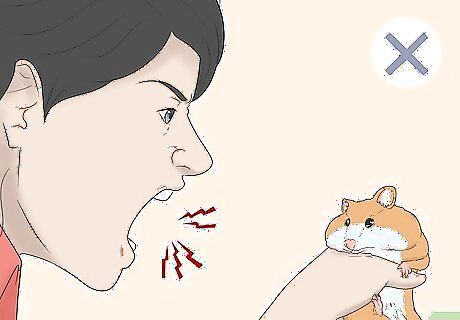
Do not punish your hamster. Hamsters do not know how to make an association between actions and consequences. Therefore, punishing him by yelling at him or physically punishing him will only lead to your hamster seeing you as the enemy. A firm 'no' should be the strongest punishment you use. Blowing in his face, particularly when he bites you, should be enough to deter him from doing the action again.



















Comments
0 comment